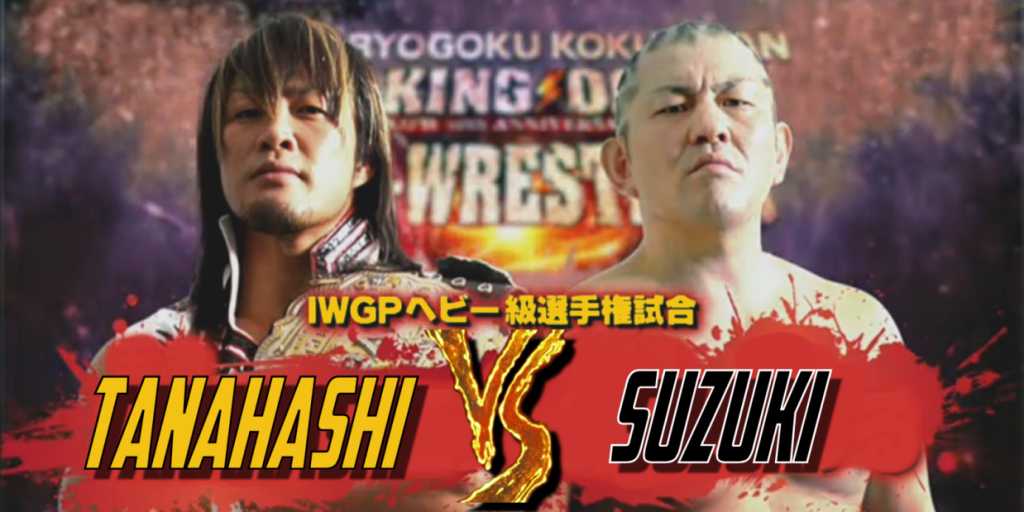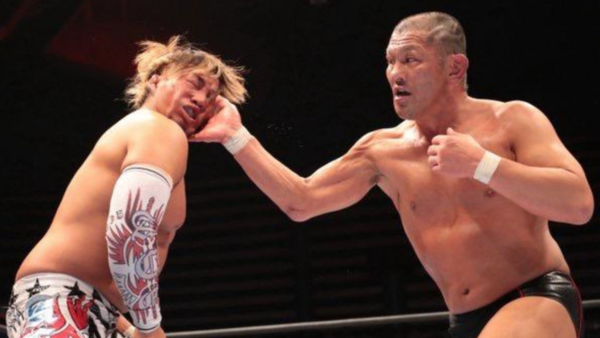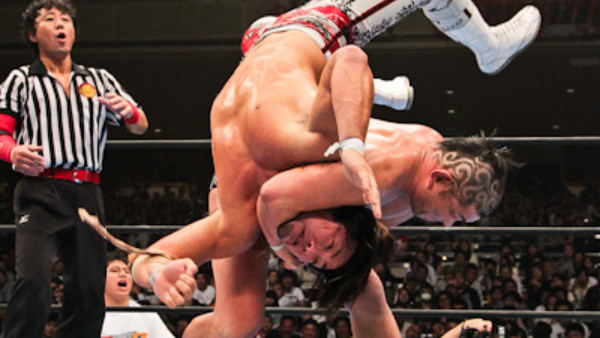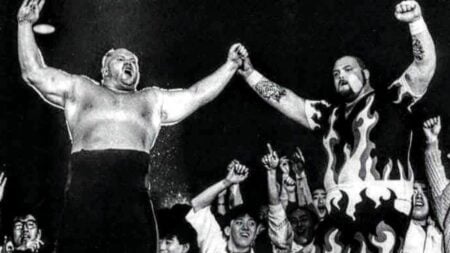On October 8th, 2012, Hiroshi Tanahashi and Minoru Suzuki put on one of the best matches in wrestling history. It was so great that the Wrestling Observer’s Dave Meltzer considered it to be better than the fabled Ric Flair-Ricky Steamboat matches from 1989.
How could one match be so great? Today, we look back and find out.

A Perfect Meeting
There couldn’t’ve been a better challenger for Tanahashi in 2012 than Suzuki. Tanahashi was the ace of NJPW and he symbolized the company entering a new era.
It was Tanahashi that had carried NJPW on his back through its darkest era and saved them from certain doom. Because of that, many, many people held Tanahashi in high regard. But Tanahashi still had his detractors.
Some purists didn’t like this high-flying John Cena wannabe pretty boy and preferred the old school grapplers of yesteryear.
Those detractors found themselves, someone, they could cheer for in Suzuki when Suzuki challenged Tanahashi for his IWGP Heavyweight Championship.
These two men were perfect opponents for each other. Despite boasting different backgrounds, both men excelled at submissions and scientific wrestling.
Tanahashi loved weakening his opponents’ legs with the dragon screw leg whip while Suzuki found joy in trying to break his opponents’ arms. But that’s where the similarities end.
Tanahashi was a smiling, optimistic, do-no-wrong hero loyal to NJPW no matter what. Meanwhile, Suzuki was a self-centered, opportunistic sadist that wrestled for whichever company paid him the most.
And while Tanahashi’s wrestling style was artistic and inspired by lucha libre, Suzuki was a cold pragmatist that made the most out of the simplest moves.
Hiroshi Tanahashi vs Minoru Suzuki
King of Pro Wrestling 2012
The Ace is On Point
Although Tanahashi was undoubtedly NJPW’s ace at this point, it would’ve done him a great deal to defeat the legendary Suzuki in singles competition.
For Suzuki was as ‘legit’ as they got in Japan. He co-founded PANCRASE, one of the first MMA organizations in Japan.
His own MMA career boasted a 30-19 win/loss record, 22 of those wins being by submission. He was a former 2-time AJPW Triple Crown Heavyweight Champion, and had won numerous other accolades in both pro wrestling and MMA.
In fact, his first wrestling teacher was none other than Karl Gotch, a grappler so revered in Japan that they actually called him the ‘God of Wrestling’.
So for Tanahashi, this match was doubly serious. Not only was his position as champion and company ace being threatened, but he had to climb a seemingly-insurmountable mountain.
Would Tanahashi be able to overcome a wrestler that was trained by ‘God’ Himself, or would Suzuki out-grapple him and become champion?
A Unique Approach
This match was grounded in a visceral, scientific logic from the opening bell. Tanahashi’s left arm was taped up, making it a bull’s eye for Suzuki.
He attacked that arm relentlessly throughout the match, going back to it whenever he could. But Tanahashi was just as smart and knew that he had to fight fire with fire. So he attacked Suzuki’s right leg, which made it harder for Suzuki to move around.
At first, it was Tanahashi that found himself in trouble. He got too cocky, allowing Suzuki to lock in a rope-hung armbar.
From there, Suzuki attacked that arm with painful-looking submission holds. And many of those looked like they were legitimately painful, thanks to Suzuki’s legit experience as an MMA fighter.
Even with the tired ‘wrestling is fake’ cliché in peoples’ minds, Tanahashi looked to be in real pain because Suzuki was wrenching those holds in as hard as possible. Just because he could.

But Suzuki copied Tanahashi too much and likewise got too cocky. Because he went for a running kick and walked into the first (of many) dragon screw leg whips.
Suddenly, Suzuki was in serious trouble. Tanahashi found an opening and exploited it without stopping.
He dropkicked Suzuki’s leg as much as possible, keeping him grounded (just like his mentor, Keiji Mutoh). Suzuki could barely even stand on both legs, much less mount an offensive comeback.
Hiroshi Tanahashi vs Minoru Suzuki
The Battle Continues
So he had to wait for another opening, which soon came in the form of a suplex attempt. Suzuki countered a waist lock into a kimura lock and from there was able to regain the advantage.
Because he didn’t need to pin Tanahashi; that required hitting a big power move like his Gotch-style Piledriver, which in turn required that his legs be at full strength (which they weren’t).
But making Tanahashi – the ace of NJPW – tap out was a pretty easy thing for Suzuki to do. Especially since he didn’t have to exert as much strength from his entire body and Tanahashi had a badly-weakened arm.
From there, it just became a question of who’d give up first. Would Tanahashi succumb because his left arm was basically useless? Or would Suzuki quit because he could barely stand?

At first, it seemed that Suzuki would give up first. Those dropkicks, dragon screws, and a lengthy Figure-4 leglock made his legs so weak he couldn’t even run the ropes.
So he decided to take control a different way: by slapping the taste out of Tanahashi’s mouth. And while Tanahashi tried to fire back with slaps of his own, he couldn’t match Suzuki, especially after Suzuki kicked his weakened arm, exposing his head even further.
Hiroshi Tanahashi vs Minoru Suzuki
Desperation
And when that didn’t work, Suzuki resorted to a time-tested classic: the sleeper hold. This simple move was as legit as they got, and it could’ve ended Tanahashi at any given moment.
Yet somehow, Tanahashi willed his way through and reached the ropes. Getting desperate, Suzuki went back to the stiff slaps, and even went back to the sleeper after Tanahashi tried a desperation dragon screw.
But Tanahashi still wouldn’t stay down. So Suzuki had to take Tanahashi by surprise, which he did by getting his knees up to block a High Fly Flow.
In doing so, Suzuki stopped Tanahashi’s momentum, but also damaged his own leg in the process.
By this point, the fans started chanting for Suzuki, even though he was the clear villain in this story. They respected his fighting spirit so much that they couldn’t help but show appreciation.
In the end, Suzuki’s strategy proved inferior as he couldn’t keep Tanahashi grounded. He tried to get Tanahashi to tap out, but had neglected to take Tanahashi’s high-flying abilities into consideration.
Because of that, Tanahashi managed to expose Suzuki for his frog splash finisher, the high Fly Flow. Two of them in quick succession were enough for Tanahashi to score a victory, causing some fans to literally jump out of their seats in joy.
Legacy
This match was unique as far as iconic matches go. From bell to bell, it contained only a single pinfall, and that was the one that ended the match.
For the preceding twenty-nine minutes, Tanahashi and Suzuki just grappled. They kept to their respective strategies with laser focus and only ever broke from them to weaken another body part.

Many people expect big matches to be sprinkled with near-falls to add more drama. After all, that has been the conventional wisdom in professional wrestling for decades.
You wear down your opponent, go for a few pins to weaken them some more. And when they kick out, it gives the audience something exciting to sink into. Then, once the match ends with a big pinfall, you’ll have taken the audience on a rollercoaster of ups and downs.
This was not that sort of match.
The Match’s Focus and Direction
Instead of filling the match with empty pinfall attempts that would obviously get kicked out of, Tanahashi and Suzuki focused on logic.
They weakened each other with only submission holds and a handful of signature maneuvers designed to weaken one body part or another. In doing so, this match became a pure endurance contest, one that could end at any time.
Tanahashi and Suzuki had done so much damage to each other that any submission hold could conceivably end the match. That left fans watching tensely as the action unfolded.
This match really stands out because of how much it defies modern wrestling conventions. You can find thousands of matches that have countless dramatic near-falls in them.
You can find just as many filled with crazy daredevil acrobatics that makes fans scream at the top of their lungs. And you can also find plenty of matches filled with crazy big moves that are executed just for the hell of it.
But you won’t find a lot of matches focused almost exclusively on submission holds. And you will find even fewer that have those submission holds done in such a way that it turns the grappling match into a fantastic and believable endurance contest.
And you’ll find fewer still that have the believability and drama that Tanahashi and Suzuki displayed here.
In that sense, this really is a one-of-a-kind wrestling match and a damned good one at that. To think this all happened on this day in pro wrestling history.






